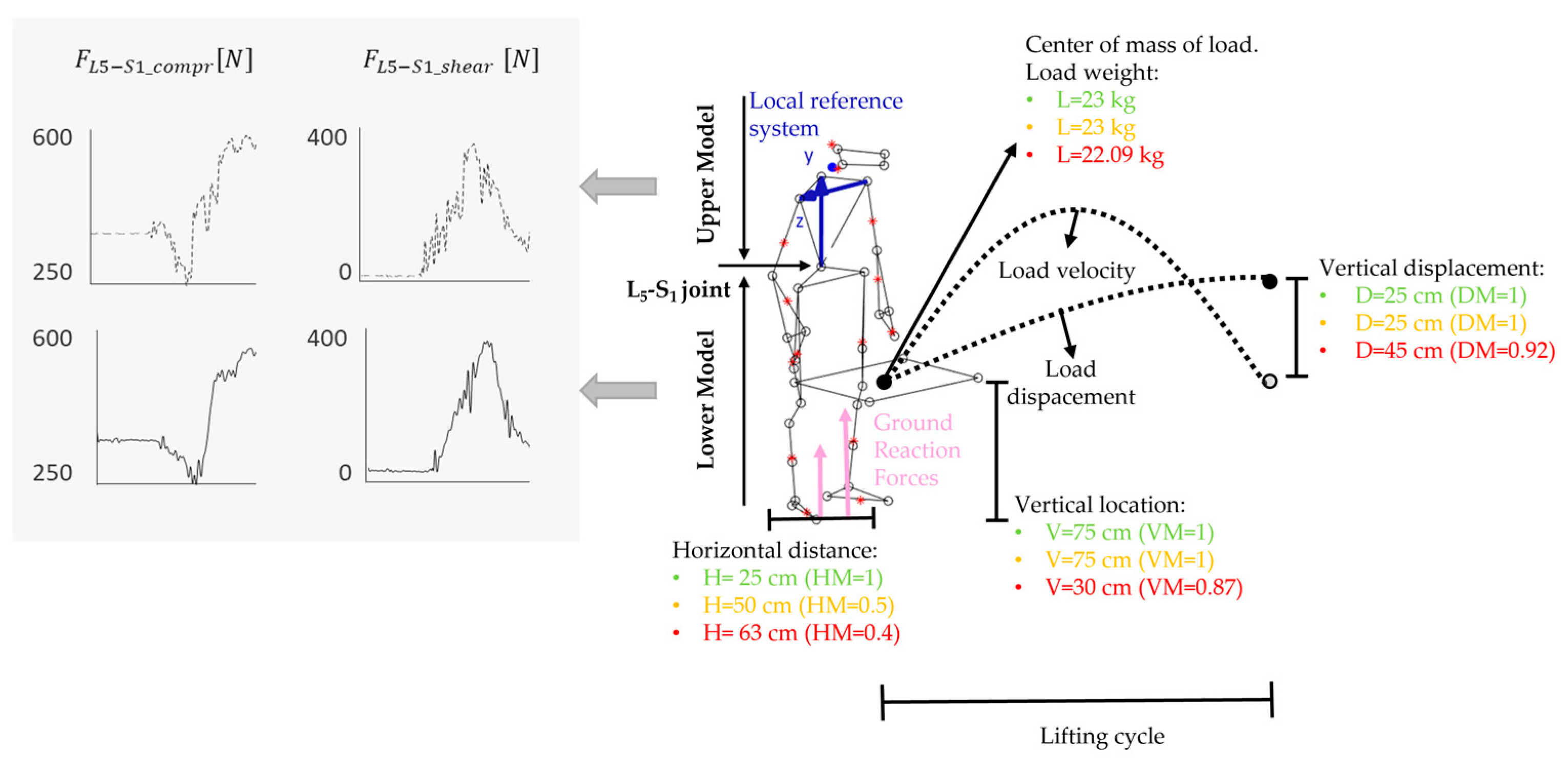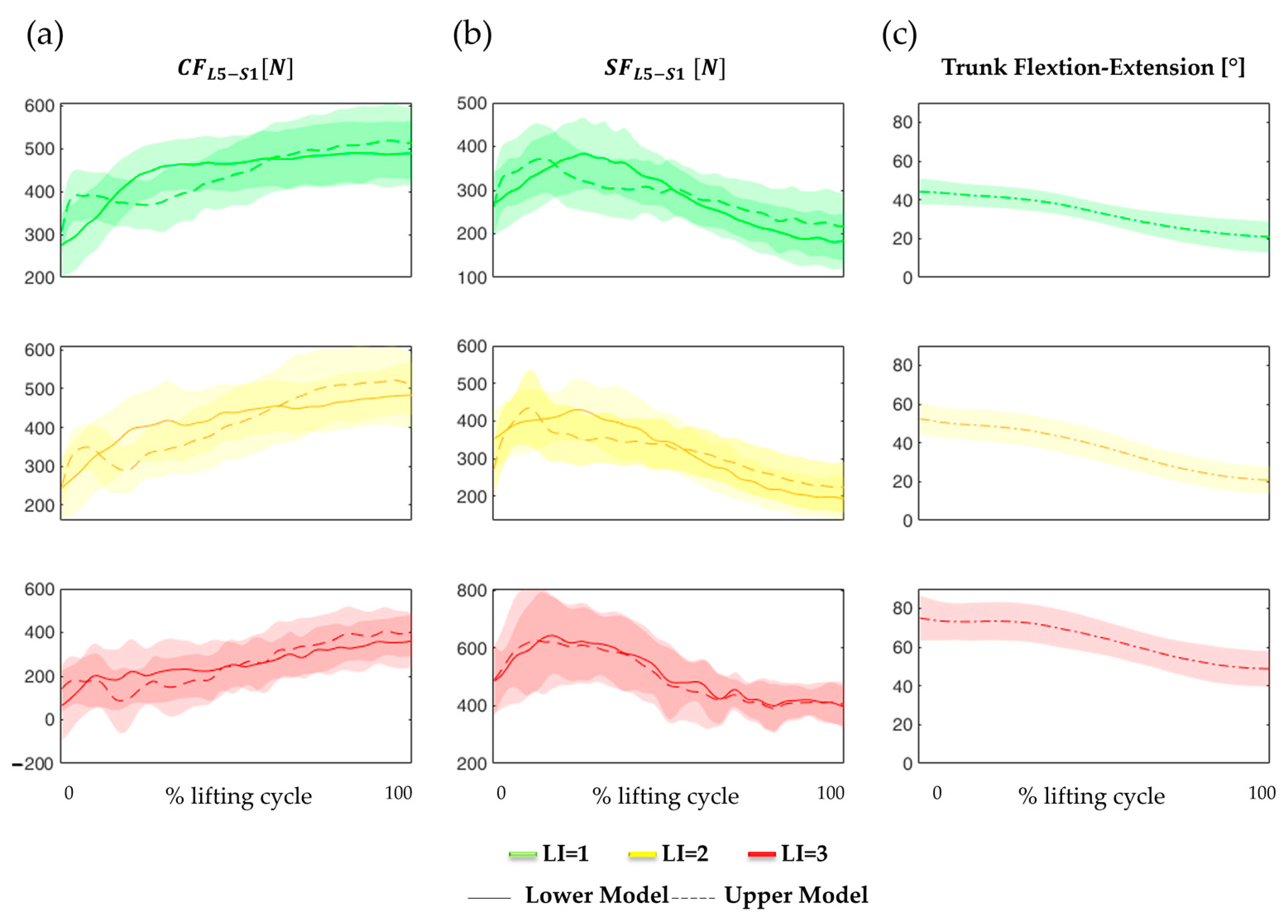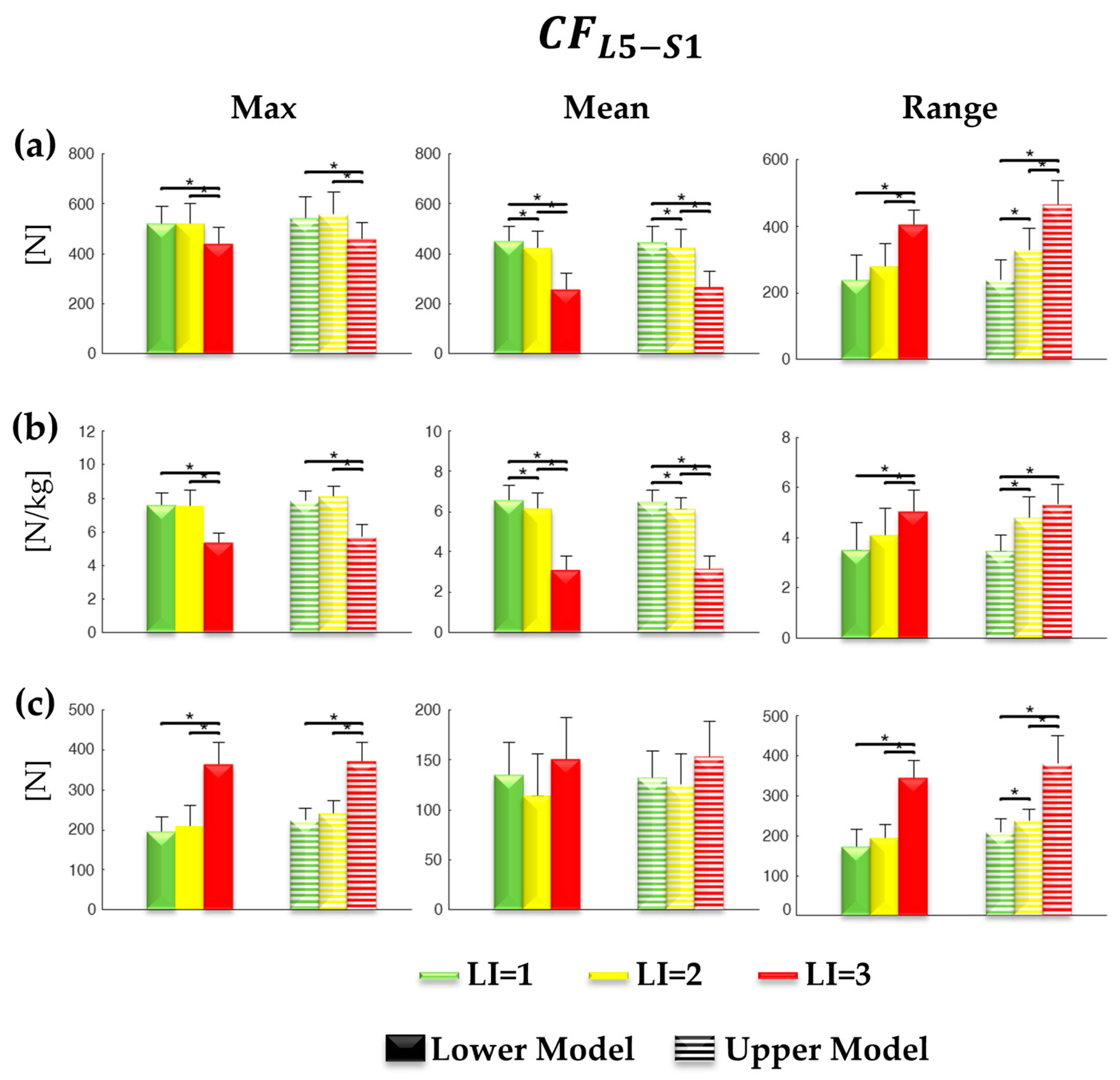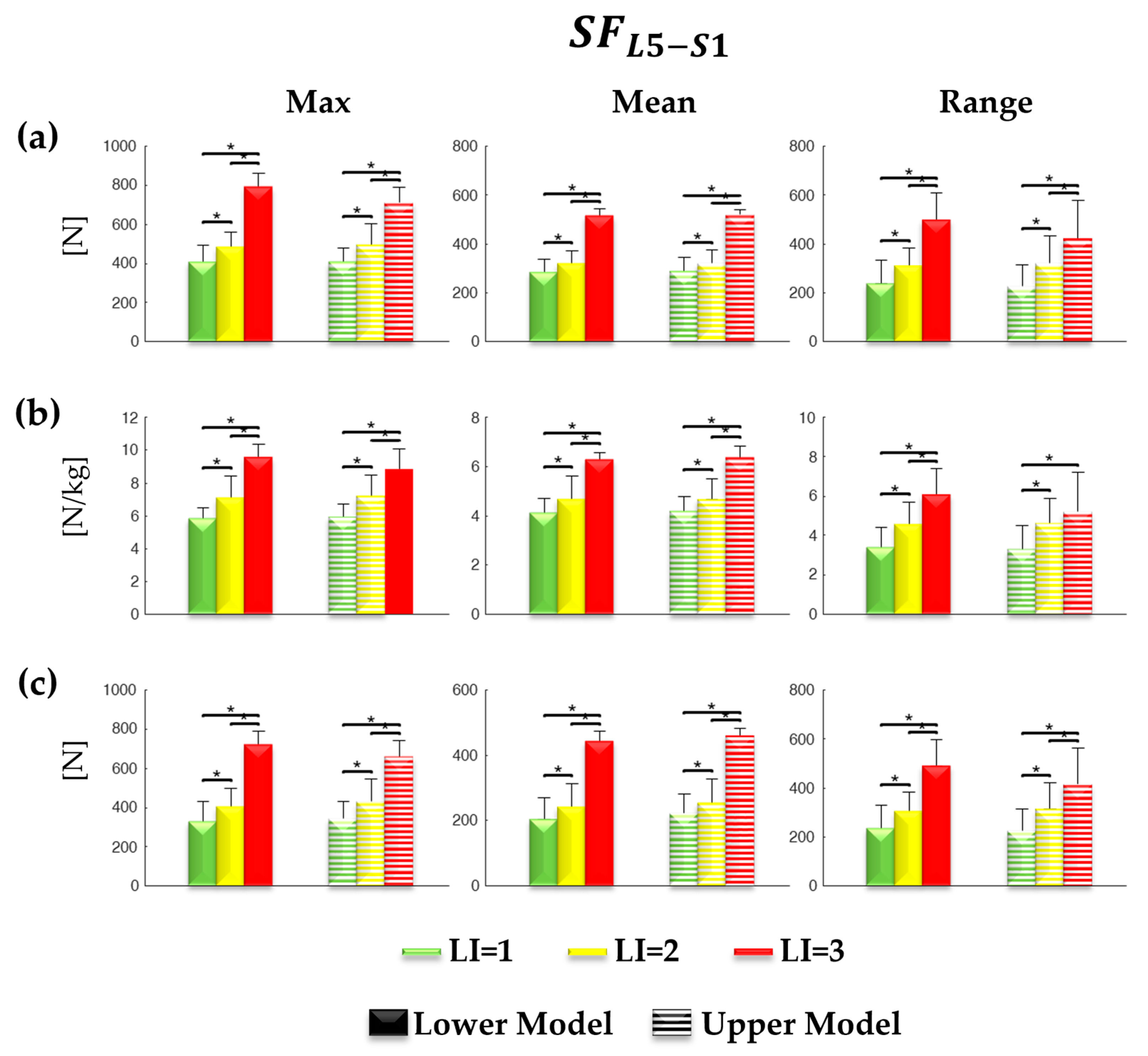Lifting Activities Assessment Using Lumbosacral Compression and Shear Forces
Abstract
1. Introduction
2. Materials and Methods
2.1. Subjects
2.2. Kinematic and Kinetic Recordings
2.3. Experimental Procedures
2.4. Data Analysis
2.4.1. Lifting Cycle Detection
2.4.2. Force Calculation
- is the rth external force;
- is the number of external forces;
- is the number of body segments considered;
- is the acceleration of gravity;
2.5. Statistical Analysis
3. Results
4. Discussion
Author Contributions
Funding
Institutional Review Board Statement
Informed Consent Statement
Data Availability Statement
Conflicts of Interest
References
- Bosch, T.; van Eck, J.; Knitel, K.; de Looze, M. The effects of a passive exoskeleton on muscle activity, discomfort and endurance time in forward bending work. Appl. Ergon. 2016, 54, 212–217. [Google Scholar] [CrossRef] [PubMed]
- Alemi, M.M.; Geissinger, J.; Simon, A.A.; Chang, S.E.; Asbeck, A.T. A passive exoskeleton reduces peak and mean EMG during symmetric and asymmetric lifting. J. Electromyogr. Kinesiol. 2019, 47, 25–34. [Google Scholar] [CrossRef] [PubMed]
- Flor-Unda, O.; Casa, B.; Fuentes, M.; Solorzano, S.; Narvaez-Espinoza, F.; Acosta-Vargas, P. Exoskeletons: Contribution to Occupational Health and Safety. Bioengineering 2023, 10, 1039. [Google Scholar] [CrossRef] [PubMed]
- Waters, T.; Putz-Anderson, V.; Garg, A. Applications Manual for the Revised NIOSH Lifting Equation; DHHS Publication: Cincinnati, OH, USA, 1994. Available online: https://stacks.cdc.gov/view/cdc/5434 (accessed on 2 February 2024).
- Waters, T.R.; Putz-Anderson, V.; Garg, A.; Fine, L.J. Revised NIOSH equation for the design and evaluation of manual lifting tasks. Ergonomics 1993, 36, 749–776. [Google Scholar] [CrossRef] [PubMed]
- ISO/DIS 11228-1; Ergonomics—Manual Handling—Part 1: Lifting and Carrying. ISO: Geneva, Switzerland, 2003.
- ISO 11228-2; Ergonomics—Manual Handling—Part 2: Pushing and Pulling. ISO: Geneva, Switzerland, 2007.
- ISO/DIS 11228-3; Ergonomics—Manual Handling—Part 3: Handling of Low Loads at High Frequency. ISO: Geneva, Switzerland, 2007.
- Ranavolo, A.; Ajoudani, A.; Cherubini, A.; Bianchi, M.; Fritzsche, L.; Iavicoli, S.; Sartori, M.; Silvetti, A.; Vanderborght, B.; Varrecchia, T.; et al. The Sensor-Based Biomechanical Risk Assessment at the Base of the Need for Revising of Standards for Human Ergonomics. Sensors 2020, 20, 5750. [Google Scholar] [CrossRef] [PubMed]
- CWA 17938:2023; Guideline for Introducing and Implementing Real-Time Instrumental-Based Tools for Biomechanical Risk Assessment. CEN-CENELEC Management Centre: Belgium, 2023. Available online: https://www.cencenelec.eu/media/CEN-CENELEC/CWAs/RI/2023/cwa17938_2023.pdf (accessed on 10 July 2024).
- Armstrong, T.J.; Burdorf, A.; Descatha, A.; Farioli, A.; Graf, M.; Horie, S.; Marras, W.S.; Potvin, J.R.; Rempel, D.; Spatari, G.; et al. Scientific basis of ISO standards on biomechanical risk factors. Scand. J. Work. Environ. Health 2018, 44, 323–329. [Google Scholar] [CrossRef] [PubMed]
- Ranavolo, A.; Draicchio, F.; Varrecchia, T.; Silvetti, A.; Iavicoli, S. Wearable Monitoring Devices for Biomechanical Risk Assessment at Work: Current Status and Future Challenges—A Systematic Review. Int. J. Environ. Res. Public Health 2018, 15, 2001, Erratum in Int. J. Environ. Res. Public Health 2018, 15, 2569. [Google Scholar] [CrossRef] [PubMed]
- Ranavolo, A.; Varrecchia, T.; Iavicoli, S.; Marchesi, A.; Rinaldi, M.; Serrao, M.; Conforto, S.; Cesarelli, M.; Draicchio, F. Surface electromyography for risk assessment in work activities designed using the “revised NIOSH lifting equation”. Int. J. Ind. Ergon. 2018, 68, 34–45. [Google Scholar] [CrossRef]
- Ranavolo, A.; Varrecchia, T.; Rinaldi, M.; Silvetti, A.; Serrao, M.; Conforto, S.; Draicchio, F. Mechanical lifting energy consumption in work activities designed by means of the “revised NIOSH lifting equation”. Ind. Health 2017, 55, 444–454. [Google Scholar] [CrossRef]
- Varrecchia, T.; De Marchis, C.; Rinaldi, M.; Draicchio, F.; Serrao, M.; Schmid, M.; Conforto, S.; Alberto, R. Lifting activity assessment using surface electromyographic features and neural networks. Int. J. Ind. Ergon. 2018, 66, 1–9. [Google Scholar] [CrossRef]
- Varrecchia, T.; De Marchis, C.; Draicchio, F.; Schmid, M.; Conforto, S.; Alberto, R. Lifting activity assessment using kinematic features and neural networks. Appl. Sci. 2020, 10, 1989. [Google Scholar] [CrossRef]
- Chini, G.; Varrecchia, T.; Conforto, S.; De Nunzio, A.M.; Draicchio, F.; Falla, D.; Ranavolo, A. Trunk stability in fatiguing frequency-dependent lifting activities. Gait Posture 2023, 102, 72–79. [Google Scholar] [CrossRef] [PubMed]
- Ranavolo, A.; Ajoudani, A.; Chini, G.; Lorenzini, M.; Varrecchia, T. Adaptive Lifting Index (aLI) for Real-Time Instrumental Biomechanical Risk Assessment: Concepts, Mathematics, and First Experimental Results. Sensors 2024, 24, 1474. [Google Scholar] [CrossRef] [PubMed]
- Wu, G.; Siegler, S.; Allard, P.; Kirtley, C.; Leardini, A.; Rosenbaum, D.; Whittle, M.; D’Lima, D.D.; Cristofolini, L.; Witte, H.; et al. Standardization and Terminology Committee of the International Society of Biomechanics ISB recommendation on definitions of joint coordinate system of various joints for the reporting of human joint motion—Part I: Ankle, hip, and spine. J. Biomech. 2002, 35, 543–548. [Google Scholar] [CrossRef] [PubMed]
- Wu, G.; van der Helm, F.C.; Veeger, H.E.; Makhsous, M.; Van Roy, P.; Anglin, C.; Nagels, J.; Karduna, A.R.; McQuade, K.; Wang, X.; et al. International Society of Biomechanics. ISB Recommendation on Definitions of Joint Coordinate Systems of Various Joints for the Reporting of Human Joint Motion. Part II.; Shoulder, Elbow, Wrist and Hand. J. Biomech. 2005, 38, 981–992. [Google Scholar] [CrossRef] [PubMed]
- Gutierrez-Farewik, E.M.; Bartonek, A.; Saraste, H. Comparison and evaluation of two common methods to measure center of mass displacement in three dimensions during gait. Hum. Mov. Sci. 2006, 25, 238–256. [Google Scholar] [CrossRef] [PubMed]
- Rab, G.; Petuskey, K.; Bagley, A. A method for determination of upper extremity kinematics. Gait Posture 2002, 15, 113–119. [Google Scholar] [CrossRef]
- Davis, R.B., 3rd; Õunpuu, S.; Tyburski, D.; Gage, J.R. A gait analysis data collection and reduction technique. Hum. Mov. Sci. 1991, 10, 575–587. [Google Scholar] [CrossRef]
- Plamondon, A.; Gagnon, M.; Desjardins, P. Validation of two 3-D segment models to calculate the net reaction forces and moments at the L5/S1 joint in lifting. Clin. Biomech. 1996, 11, 101–110. [Google Scholar] [CrossRef]
- Zatsiorsky, V.M.; Seluyanov, V.N.; Chugunova, L.G. Methods of Determining Mass-Inertial Characteristics of Human Body Segments; Chernyi, G.G., Regirer, S.A., Eds.; Contemporary Problems of Biomechanics: Boca Raton, FL, USA, 1990; pp. 272–291. [Google Scholar]
- de Leva, P. Adjustments to Zatsiorsky-Seluyanov’s segment inertia parameters. J. Biomech. 1996, 29, 1223–1230. [Google Scholar] [CrossRef]
- Armstrong, D.P.; Fischer, S.L. Understanding individual differences in lifting mechanics: Do some people adopt motor control strategies that minimize biomechanical exposure. Hum. Mov. Sci. 2020, 74, 102689. [Google Scholar] [CrossRef] [PubMed]
- Ranavolo, A.; Mari, S.; Conte, C.; Serrao, M.; Silvetti, A.; Iavicoli, S.; Draicchio, F. A new muscle co-activation index for biomechanical load evaluation in work activities. Ergonomics 2015, 58, 966–979. [Google Scholar] [CrossRef] [PubMed]
- Arjmand, N.; Plamondon, A.; Shirazi-Adl, A.; Lariviere, C.; Parnianpour, M. Predictive equations to estimate spinal loads in symmetric lifting tasks. J. Biomech. 2011, 44, 84–91. [Google Scholar] [CrossRef] [PubMed]
- Naing, L.; Winn, T.; Rusli, B.N. Practical issues in calculating the sample size for prevalence studies. Arch. Orofac. Sci. 2006, 1, 9–14. [Google Scholar]
- Fillingim, R.B.; King, C.D.; Ribeiro-Dasilva, M.C.; Rahim-Williams, B.; Riley, J.L. Sex, gender, and pain: A review of recent clinical and experimental findings. J. Pain 2009, 10, 447–485. [Google Scholar] [CrossRef] [PubMed]
- Hunter, S.K. Sex differences in human fatigability: Mechanisms and insight to physiological responses. Acta Physiol. 2014, 210, 768–789. [Google Scholar] [CrossRef] [PubMed]
- Sullivan, B.E.; Carroll, C.C.; Jemiolo, B.; Trappe, S.W.; Magnusson, S.P.; Dossing, S.; Kjaer, M.; Trappe, T.A. Effect of acute resistance exercise and sex on human patellar tendon structural and regulatory mRNA expression. J. Appl. Physiol. 2009, 106, 468–475. [Google Scholar] [CrossRef] [PubMed][Green Version]
- Johansen, T.; Samani, A.; Antle, D.; Côté, J.N.; Madeleine, P. Gender effects on the coordination of subdivisions of the trapezius muscle during a repetitive box-folding task. Eur. J. Appl. Physiol. 2013, 113, 175–182. [Google Scholar] [CrossRef]
- Sartori, M.; Reggiani, M.; Farina, D.; Lloyd, D.G. EMG-Driven Forward-Dynamic Estimation of Muscle Force and Joint Moment about Multiple Degrees of Freedom in the Human Lower Extremity. PLoS ONE 2012, 7, e52618. [Google Scholar] [CrossRef]
- Moya-Esteban, A.; van der Kooij, H.; Sartori, M. Robust estimation of lumbar joint forces in symmetric and asymmetric lifting tasks via large-scale electromyography-driven musculoskeletal models. J. Biomech. 2022, 144, 111307. [Google Scholar] [CrossRef]
- Lloyd, D.G.; Besier, T.F. An EMG-driven musculoskeletal model to estimate muscle forces and knee joint moments in vivo. J. Biomech. 2003, 36, 765–776. [Google Scholar] [CrossRef]




| Segment | Markers | Mass (%Mass) | CM (%Length) | ||
|---|---|---|---|---|---|
| Female | Male | Female | Male | ||
| Head | Temple and posterior-superior parietal bone | 6.68 | 6.94 | 58.94 | 59.76 |
| Trunk | seventh vertebrae, acromions, sacrum and anterior superior iliac spines | 42.57 | 43.46 | 41.51 | 44.86 |
| Pelvis | sacrum, rasis and l asis | 12.47 | 11.17 | 49.2 | 61.15 |
| Upper Arm | Acromion and olecranon | 2.55 | 2.71 | 57.54 | 57.72 |
| Forearm | olecranon and radial processes | 1.38 | 1.62 | 45.59 | 45.74 |
| Hand | radial processes and head of the third metacarpal bone | 0.56 | 0.61 | 74.74 | 79 |
| Thigh | great trochanter and lateral femoral condyle | 14.78 | 14.16 | 36.12 | 40.95 |
| Shank | lateral femoral condyle and fibula head | 4.81 | 4.33 | 44.16 | 44.59 |
| Foot | metatarsal head and heel | 1.29 | 1.37 | 40.14 | 44.15 |
| Maximum | Mean | Range | ||
|---|---|---|---|---|
| Lower Model | [N] | F = 17.515, df = 2, p < 0.001 | F = 103.466, df = 2, p < 0.001 | F = 40.791, df = 2, p < 0.001 |
| [N/kg] | F = 79.112, df = 2, p < 0.001 | F = 165.761, df = 2, p < 0.001 | F = 13.255, df = 2, p < 0.001 | |
| | [N] | F = 83.555, df = 2, p < 0.001 | F = 5.457, df = 2, p = 0.058 | F = 89.527, df = 2, p < 0.001 | |
| Upper Model | [N] | F = 17.343, df = 2, p < 0.001 | F = 72.977, df = 2, p < 0.001 | F = 63.171, df = 2, p < 0.001 |
| [N/kg] | F = 79.155, df = 2, p < 0.001 | F = 201.366, df = 2, p < 0.001 | F = 44.220, df = 2, p < 0.001 | |
| | [N] | F = 107.897, df = 2, p < 0.001 | F = 4.899, df = 2, p = 0.013 | F = 58.671, df = 2, p < 0.001 | |
| Lower Model | [N] | F = 214.901, df = 2, p < 0.001 | F = 217.721, df = 2, p < 0.001 | F = 66.483, df = 2, p < 0.001 |
| [N/kg] | F = 89.655, df = 2, p < 0.001 | F = 77.830, df = 2, p < 0.001 | F = 34.145, df = 2, p < 0.001 | |
| | [N] | F = 182.187, df = 2, p < 0.001 | F = 165.385, df = 2, p < 0.001 | F = 63.568, df = 2, p < 0.001 | |
| Upper Model | [N] | F = 78.062, df = 2, p < 0.001 | F = 205.992, df = 2, p < 0.001 | F = 13.265, df = 2, p < 0.001 |
| [N/kg] | F = 98.477, df = 2, p < 0.001 | F = 39.379, df = 2, p < 0.001 | F = 7.883, df = 2, p = 0.001 | |
| | [N] | F = 75.125, df = 2, p < 0.001 | F = 179.363, df = 2, p < 0.001 | F = 13.497, df = 2, p < 0.001 |
| LI | Maximum | Mean | Range | |||||
|---|---|---|---|---|---|---|---|---|
| p Value | Cohen’s d | p Value | Cohen’s d | p Value | Cohen’s d | |||
| Lower Model | [N] | 1 vs. 2 | 1.000 | 0.007 | 0.005 | 0.41 | 0.053 | 0.55 |
| 1 vs. 3 | 0.001 | 1.16 | <0.001 | 2.99 | <0.001 | 2.63 | ||
| 2 vs. 3 | 0.001 | 1.05 | <0.001 | 2.37 | <0.001 | 2.10 | ||
| [N/kg] | 1 vs. 2 | 1.000 | 0.02 | 0.008 | 0.52 | 0.066 | 0.53 | |
| 1 vs. 3 | <0.001 | 3.16 | <0.001 | 4.74 | 0.002 | 1.52 | ||
| 2 vs. 3 | <0.001 | 2.74 | <0.001 | 3.95 | 0.010 | 0.95 | ||
| | [N] | 1 vs. 2 | 0.487 | 0.32 | 0.051 | 0.54 | 0.178 | 0.55 | |
| 1 vs. 3 | <0.001 | 3.57 | 0.595 | 0.42 | <0.001 | 3.78 | ||
| 2 vs. 3 | <0.001 | 2.86 | 0.053 | 0.87 | <0.001 | 3.72 | ||
| Upper Model | [N] | 1 vs. 2 | 0.107 | 0.17 | 0.018 | 0.29 | <0.001 | 1.37 |
| 1 vs. 3 | 0.003 | 1.08 | <0.001 | 2.71 | <0.001 | 3.28 | ||
| 2 vs. 3 | 0.001 | 1.22 | <0.001 | 2.19 | <0.001 | 1.95 | ||
| [N/kg] | 1 vs. 2 | 0.054 | 0.42 | 0.016 | 0.59 | <0.001 | 1.72 | |
| 1 vs. 3 | <0.001 | 3.05 | <0.001 | 5.28 | <0.001 | 2.46 | ||
| 2 vs. 3 | <0.001 | 3.40 | <0.001 | 4.83 | 0.098 | 0.64 | ||
| | [N] | 1 vs. 2 | 0.062 | 0.52 | 0.850 | 0.23 | 0.003 | 0.86 | |
| 1 vs. 3 | <0.001 | 3.65 | 0.105 | 0.64 | <0.001 | 3.09 | ||
| 2 vs. 3 | <0.001 | 3.13 | 0.078 | 0.81 | <0.001 | 2.62 | ||
| Lower Model | [N] | 1 vs. 2 | 0.001 | 0.94 | 0.013 | 0.64 | 0.001 | 0.85 |
| 1 vs. 3 | <0.001 | 4.82 | <0.001 | 5.22 | <0.001 | 2.51 | ||
| 2 vs. 3 | <0.001 | 4.06 | <0.001 | 4.39 | <0.001 | 1.98 | ||
| [N/kg] | 1 vs. 2 | 0.001 | 1.18 | 0.014 | 0.68 | 0.002 | 1.08 | |
| 1 vs. 3 | <0.001 | 5.06 | <0.001 | 4.59 | 0.002 | 2.25 | ||
| 2 vs. 3 | <0.001 | 2.25 | <0.001 | 2.29 | 0.001 | 1.21 | ||
| | [N] | 1 vs. 2 | 0.001 | 0.75 | 0.006 | 0.54 | 0.001 | 0.77 | |
| 1 vs. 3 | <0.001 | 4.44 | <0.001 | 4.52 | <0.001 | 2.45 | ||
| 2 vs. 3 | <0.001 | 3.72 | <0.001 | 3.59 | <0.001 | 1.93 | ||
| Upper Model | [N] | 1 vs. 2 | 0.002 | 0.93 | 0.011 | 0.55 | 0.034 | 0.91 |
| 1 vs. 3 | <0.001 | 3.92 | <0.001 | 5.40 | 0.002 | 1.52 | ||
| 2 vs. 3 | <0.001 | 2.23 | <0.001 | 4.52 | 0.006 | 0.73 | ||
| [N/kg] | 1 vs. 2 | 0.001 | 1.15 | 0.014 | 0.66 | 0.019 | 1.04 | |
| 1 vs. 3 | <0.001 | 2.67 | <0.001 | 4.06 | 0.022 | 1.14 | ||
| 2 vs. 3 | <0.001 | 1.23 | <0.001 | 2.52 | 0.388 | 0.35 | ||
| | [N] | 1 vs. 2 | 0.002 | 0.83 | 0.007 | 0.48 | 0.032 | 0.90 | |
| 1 vs. 3 | <0.001 | 3.59 | <0.001 | 5.19 | 0.002 | 1.53 | ||
| 2 vs. 3 | <0.001 | 2.24 | <0.001 | 3.72 | 0.006 | 0.77 | ||
Disclaimer/Publisher’s Note: The statements, opinions and data contained in all publications are solely those of the individual author(s) and contributor(s) and not of MDPI and/or the editor(s). MDPI and/or the editor(s) disclaim responsibility for any injury to people or property resulting from any ideas, methods, instructions or products referred to in the content. |
© 2024 by the authors. Licensee MDPI, Basel, Switzerland. This article is an open access article distributed under the terms and conditions of the Creative Commons Attribution (CC BY) license (https://creativecommons.org/licenses/by/4.0/).
Share and Cite
Varrecchia, T.; Chini, G.; Serrao, M.; Ranavolo, A. Lifting Activities Assessment Using Lumbosacral Compression and Shear Forces. Appl. Sci. 2024, 14, 6044. https://doi.org/10.3390/app14146044
Varrecchia T, Chini G, Serrao M, Ranavolo A. Lifting Activities Assessment Using Lumbosacral Compression and Shear Forces. Applied Sciences. 2024; 14(14):6044. https://doi.org/10.3390/app14146044
Chicago/Turabian StyleVarrecchia, Tiwana, Giorgia Chini, Mariano Serrao, and Alberto Ranavolo. 2024. "Lifting Activities Assessment Using Lumbosacral Compression and Shear Forces" Applied Sciences 14, no. 14: 6044. https://doi.org/10.3390/app14146044
APA StyleVarrecchia, T., Chini, G., Serrao, M., & Ranavolo, A. (2024). Lifting Activities Assessment Using Lumbosacral Compression and Shear Forces. Applied Sciences, 14(14), 6044. https://doi.org/10.3390/app14146044








